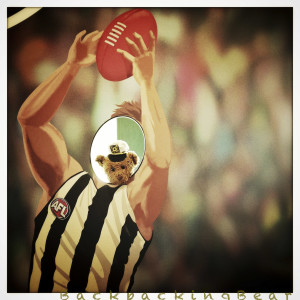Joe Louis watches a game of footy
There are several ways to experience the culture of a nation. You can dive into the delicacies of its indigenous kitchens. You can scour the genius within the books of its library. I like to jump into in the passionate fandom of the sporting world.
When I went to a Real Madrid soccer (nee football) match in Santiago Bernabeu Stadium, the crowd was swarming and boisterous. In New Zealand, any conversation can be opened with a question or comment regarding the All Blacks rugby team. Just watching the Super Bowl in the U.S. is like attending a national holiday. People of different backgrounds, different economic statuses, different beliefs all united for one goal: beat the other team. It’s a religion in its own right.

In order to fully understand the Australian people, I decided to attend a match of their beloved footie. For weeks prior, I had been overhearing stories and news about the league on the train, in the streets, and over meals. It was inescapable. So without seeing a single match, I still knew that the Essendon club was busted in a drug scandal and that Hawthorn was widely considered the best team in the league. I was excited to see what the all the fun and fuss was about.
There was only one problem. I didn’t know anything about the rules of the game. I already had to relearn the rules of “football” when attending a soccer match. Now I had to relearn the rules again for Australian football. Fortunately, the rules didn’t take long to pick up. The game is an odd combination of rugby, soccer, American football, and even a little basketball. Players mostly pass the ball to each other, before kicking it into the endzone. I appreciated the skill involved but was disappointed at the lack of highlight reel plays. There weren’t many moments equivalent to a high flying slam dunk or an ankle breaking dash up the middle of the field.

The game started off slow with St. Kilda, the home team, falling into an early hole. Even with my amateur eyes I could tell that was simply the result of sloppy play. In the second half they pulled themselves together and began to pull away from their Essendon competitors. By the end the home team upset Essendon and the crowd was visibly elated.
The train ride back to the hostel was crowded, noisy, and wonderful. Sentences referred to “our” win and how “we” kicked butt. Chants spontaneously erupted and took off across subway cars. I wasn’t wearing a player jersey or a team scarf. My accent was not from down under. But in the moment I cheered for St. Kilda with my fellow commuters, I was a local, just like the rest of us.
Melbourne, Australia
Scoring
A goal worth six points is scored when a player kicks the ball through the uprights in the end zone.
A “behind” worth one point is scored when a player gets the ball through the uprights through any other way except for kicking.
Easy enough.
Getting around
A player can advance the ball in several ways. The most frequent is to kick the ball towards a teammate. This method gets the ball the farthest per play.
A player can also “handball” the ball, or toss it to a nearby teammate.
Lastly, a player can run with the ball, but then he has to dribble it against the ground every 15m. This doesn’t happen frequently, but I enjoy it the most because it looks like they are playing basketball on a rugby field.
There are no downs or set plays, you just keep playing until the other team gets the ball back.
Playing defense
If the opposite team completes a kick from player to another it is called a mark. When this happens the defense has to play off the person with the ball, giving him a free kick at the goal or space to make another kick to a teammate.
If the opposite team completes a handball or starts to dribble the ball, then the opposite team can charge the player and tackle him, rugby-style.
That should be enough to understand what is happening in a game. Give it a try!
Resources
Australian Rules Football: http://en.wikipedia.org/wiki/Australian_rules_football#Laws_of_the_game
